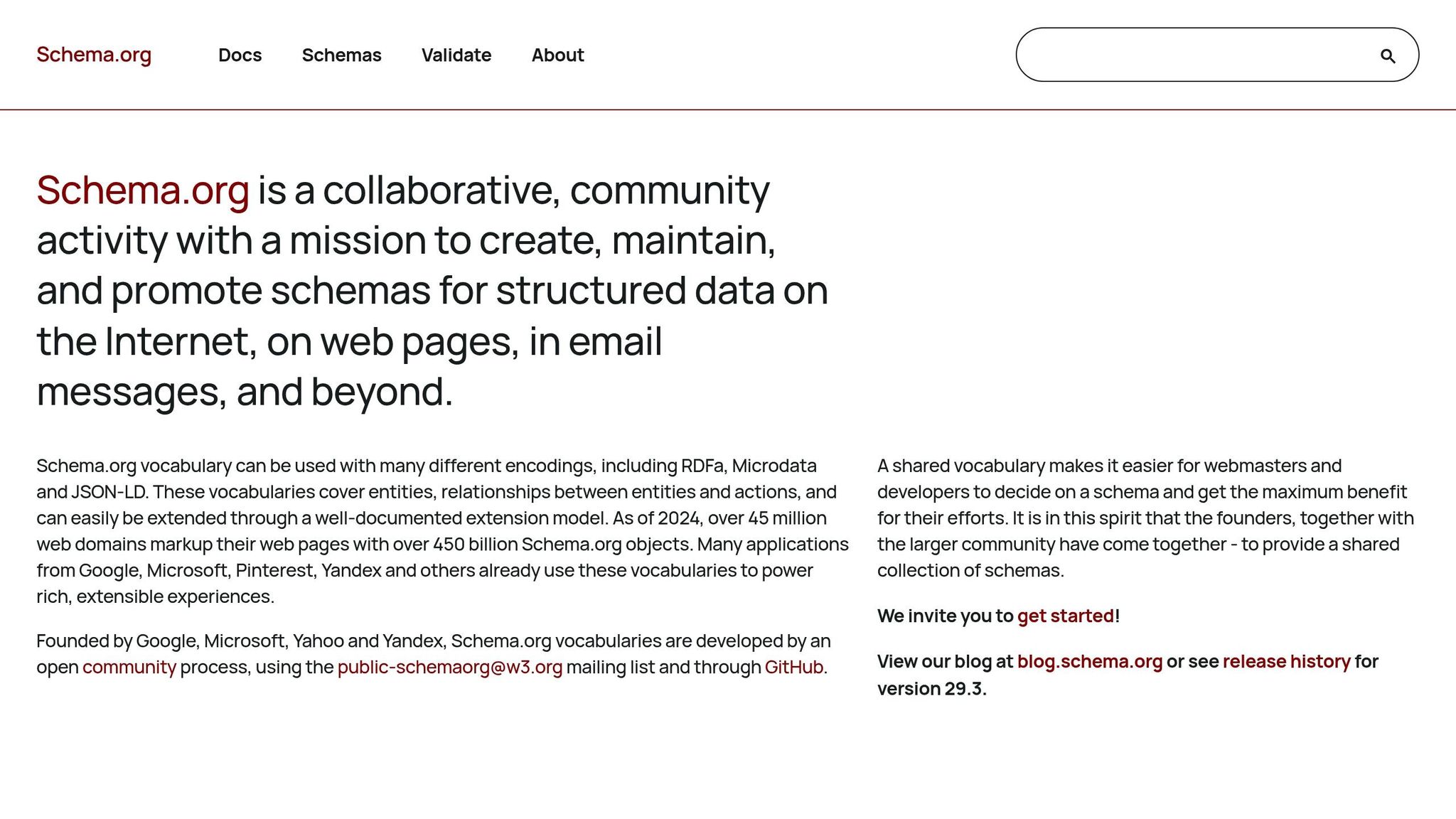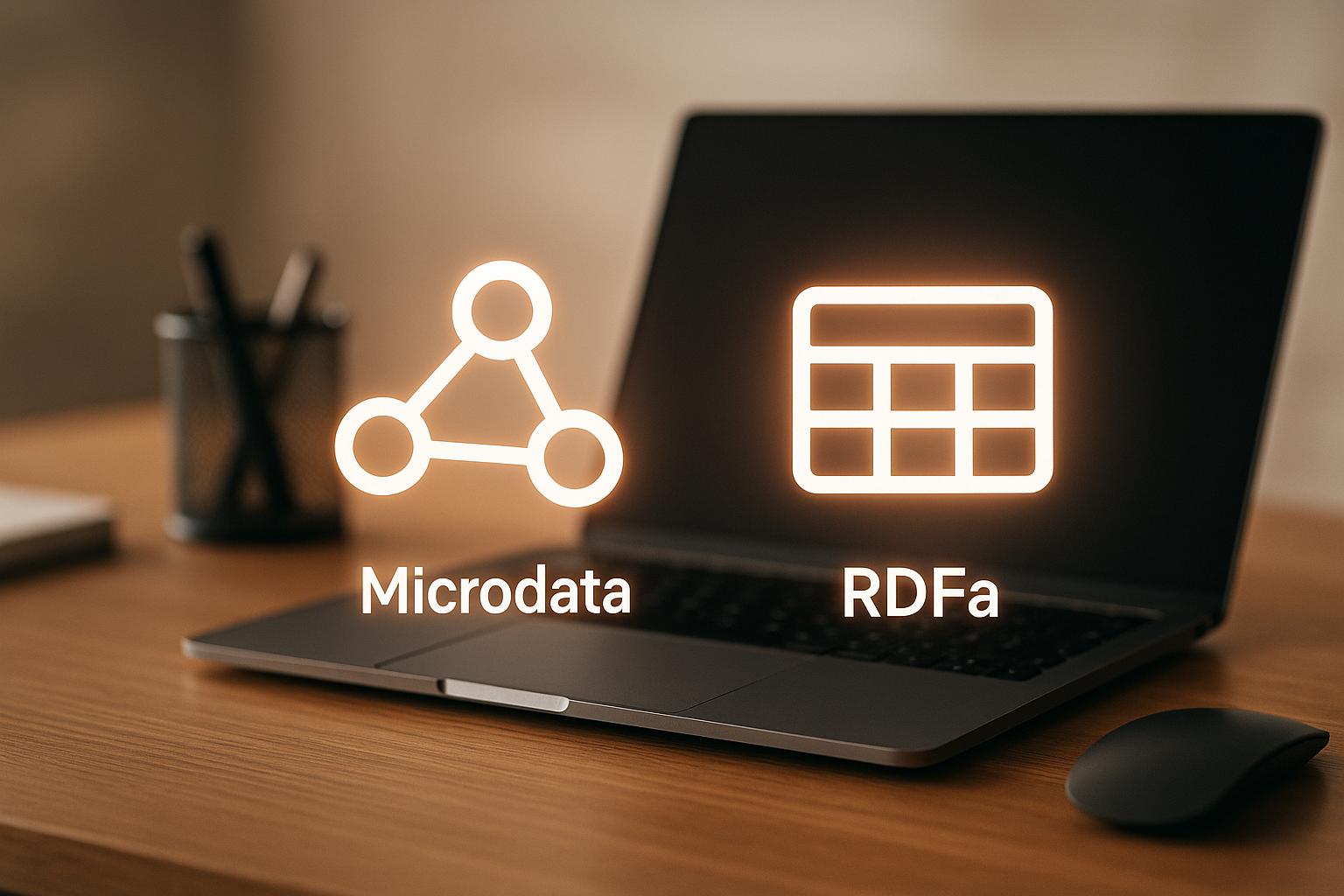When it comes to schema markup, Microdata and RDFa are two widely used options for structuring website data to improve search engine visibility. Both formats help search engines understand your content better, but they differ in complexity, flexibility, and ease of use. Here’s a quick breakdown:
- Microdata is simpler and easier to implement, making it ideal for small businesses or straightforward tasks like marking up product details or reviews.
- RDFa offers more advanced capabilities for managing complex data relationships, such as linking products to categories or handling multiple vocabularies. It works well for larger, more intricate projects but has a steeper learning curve.
Key takeaway: Choose Microdata for simplicity and RDFa for handling more detailed or interconnected data. Both formats are equally effective for SEO when implemented correctly.
Quick Comparison
| Aspect | Microdata | RDFa |
|---|---|---|
| Learning Curve | Easy to learn | Requires more expertise |
| Complex Data | Less suitable for nested structures | Handles hierarchical data effectively |
| SEO Use | Great for basic SEO needs | Best for advanced semantic modeling |
| Flexibility | Limited to Schema.org | Supports multiple vocabularies |
| Code Readability | Cleaner HTML | Adds more attributes to HTML |
Your choice should depend on your website’s needs, your team’s skills, and your long-term goals. For simple implementations, go with Microdata. If you’re dealing with larger-scale or multi-format content, RDFa might be worth the investment.
Understanding the Difference Between aggregateRating Notations in Schema.org

Microdata: Features and How It Works
Microdata makes adding schema markup to your website simple by embedding it directly into your HTML. This approach is especially appealing to businesses that prefer lightweight, no-frills solutions. For many small and medium-sized U.S. businesses, its straightforward nature makes it an efficient choice.
While comprehensive technical guides on Microdata’s attributes and its pros and cons aren’t widely available, its reputation for simplicity stands out. It’s a practical option for companies that want to implement schema markup without diving into overly complex processes.
This provides a foundation for comparing Microdata with RDFa in the following section.
RDFa: Features and How It Works
Expanding on the topic of Microdata, RDFa offers a more adaptable option for handling intricate data requirements. Its flexible markup system makes it a great choice for businesses managing complex data structures or working across multiple content management systems.
What is RDFa?
RDFa, short for Resource Description Framework in Attributes, is a markup language that uses attributes like vocab, typeof, property, and resource. These attributes allow for the integration of multiple vocabularies (such as Schema.org and Dublin Core) within a single document. RDFa is versatile, working seamlessly with both HTML and XML documents.
One of RDFa’s standout features is its ability to manage nested relationships effectively. This makes it particularly useful for organizing interconnected data, such as product catalogs that include multiple categories, brands, and customer reviews.
RDFa Pros and Cons
RDFa’s flexibility brings both opportunities and challenges, which businesses in the U.S. should weigh carefully.
Advantages of RDFa:
- Support for multiple vocabularies: Businesses can use several schemas on the same page. For example, an e-commerce site can mark up products, reviews, organizational details, and breadcrumbs simultaneously – no need to pick just one schema.
- XML compatibility: RDFa is especially useful for organizations that generate both HTML and XML outputs. For instance, news publishers often release content in multiple formats, and RDFa ensures consistent markup across these variations.
- Complex relationship mapping: RDFa excels at representing hierarchical and interconnected data. It’s ideal for businesses needing to link products to categories, brands, and reviews in a structured way.
Disadvantages of RDFa:
- Steep learning curve: Unlike Microdata, which can be picked up relatively quickly, RDFa requires a deeper understanding of namespaces, prefixes, and vocabulary management.
- Code clutter: RDFa markup can make HTML more difficult to read and maintain due to the additional attributes it requires.
- Inconsistent tool support: While major search engines can parse RDFa effectively, some validators and tools may not fully support all its features, which could lead to debugging headaches.
When to Use RDFa
RDFa shines in scenarios where its advanced capabilities justify the added complexity.
- Large-scale content operations: Media companies, universities, and government agencies often need to mark up diverse content types with multiple vocabularies. RDFa’s ability to handle these requirements makes it a strong fit for such environments.
- Enterprise e-commerce platforms: For businesses managing extensive product catalogs, RDFa offers the tools to map detailed relationships between products, categories, brands, and user-generated content.
- Content management systems with multi-format outputs: Publishing companies that distribute content across HTML websites, XML feeds, and mobile apps can rely on RDFa to ensure consistent markup across all channels.
- Semantic web integration: Organizations already using RDF databases or semantic web technologies can use RDFa to align their internal data structures with public-facing markup.
RDFa’s capabilities set the stage for a detailed comparison with Microdata, which will be explored in the next section.
Microdata vs RDFa: Side-by-Side Comparison
When deciding between Microdata and RDFa, it often comes down to balancing simplicity against the ability to handle complex data. Here’s a closer look at how they stack up.
Comparison Table: Microdata vs RDFa
The table below outlines key differences based on available sources:
| Aspect | Microdata | RDFa |
|---|---|---|
| Learning Curve | Easy to grasp for beginners; great for straightforward implementations | Requires more effort to learn, especially familiarity with RDF concepts |
| Manageability | Can become cumbersome with deeply nested structures | Designed to handle complex, hierarchical data more effectively |
| SEO Suitability | Sufficient for typical SEO tasks like marking up products or reviews | Offers advanced semantic capabilities but may be unnecessary for common SEO needs |
This table helps clarify which option might better suit your specific goals.
Practical Considerations for U.S. Businesses
Your choice between Microdata and RDFa should align with your business’s technical needs and your team’s expertise. For straightforward data like product details or customer reviews, Microdata is a user-friendly choice. But if your data is more intricate, RDFa’s ability to handle nested, hierarchical structures becomes a valuable asset.
For many U.S. businesses, especially those prioritizing search engine visibility, RDFa might feel excessive unless your projects require advanced semantic modeling. On the other hand, Microdata is a simpler starting point, especially if your developers are more familiar with standard HTML and new to structured data.
Long-term planning is also essential. While starting with Microdata is practical, switching to RDFa later can require significant resources. So, it’s worth considering not just your current needs but also your future data strategy. If your team is equipped to handle the learning curve and your business anticipates growing data complexity, RDFa could be a more scalable option in the long run.
How to Choose Between Microdata and RDFa
Deciding between Microdata and RDFa comes down to understanding your website’s specific needs and the skills of your team. The right choice will align with your site’s goals and your team’s ability to implement and manage the markup effectively.
Factors to Consider
Team expertise is a key factor. If your developers are familiar with HTML but new to structured data, Microdata is a simpler option to start with. On the other hand, if your team has experience with semantic web technologies or XML, they may find RDFa’s more intricate structure manageable.
Project complexity should also influence your decision. For straightforward tasks like tagging local business details or event information, Microdata is efficient and easy to use. However, if your project involves more intricate data relationships – such as linking research databases with contributors, institutions, and references – RDFa’s hierarchical structure is better equipped to handle the complexity.
Vocabulary requirements are another important consideration. If your structured data relies solely on Schema.org, either format will work. But if you need to use multiple vocabularies, such as combining Schema.org with industry-specific standards, RDFa offers the flexibility to manage this seamlessly.
Long-term scalability is worth thinking about, too. While Microdata can address immediate needs, transitioning to RDFa later can be time-consuming and resource-intensive. For sites planning to expand internationally or manage multilingual and multi-regional data, RDFa’s capabilities make it a more future-proof option.
Maintenance resources play a role in ongoing management. Microdata is generally easier to update, especially when content management systems automatically generate the markup. In contrast, RDFa often requires more technical oversight to ensure data relationships remain accurate as your content evolves.
How SearchX Can Help

If these considerations feel overwhelming, expert support can make the process much smoother. Structured data implementation requires both technical know-how and strategic planning. SearchX’s technical SEO services are designed to handle schema markup from start to finish, ensuring your chosen format delivers measurable improvements in search performance.
The SearchX team begins by analyzing your website’s structure to identify the best markup opportunities. Whether your site needs Microdata for simple product pages or RDFa for managing complex data relationships, they handle the technical setup while ensuring compatibility with your existing systems.
SearchX doesn’t stop at implementation. They provide ongoing monitoring to keep your structured data error-free as your site evolves. This includes regular validation checks, tracking how search engines recognize your markup, and updating implementations to align with algorithm changes or new schema options.
For businesses unsure about which format to choose, SearchX offers detailed technical audits. These audits evaluate your team’s expertise, content complexity, and growth plans to recommend the best approach for your long-term goals.
Additionally, SearchX integrates schema markup into broader SEO strategies through their SEO solutions. This ensures your structured data works in harmony with your overall optimization efforts, maximizing the impact of your investment while maintaining technical efficiency.
Conclusion
Microdata and RDFa both serve as effective tools for adding structured data to your website, but their strengths cater to different needs. Microdata is straightforward and easy to implement, making it a great choice for businesses with simple markup requirements. It works well for tasks like adding local business information, product details, or event data, especially for teams just starting with structured data.
On the other hand, RDFa shines in situations that demand more complexity. As a W3C Recommendation, it offers flexibility and standardization, making it ideal for websites with intricate content structures or those managing multiple vocabularies. Its ability to handle more sophisticated data relationships makes it a solid pick for projects with international or advanced requirements.
Both formats are equally supported by search engines, and studies indicate no difference in SEO performance when implemented correctly. This means the decision should hinge on practical factors like your team’s expertise and project demands, rather than concerns about rankings.
If your goal is quick implementation with minimal technical effort, Microdata is a reliable option. For websites aiming to scale globally or deal with complex data structures, RDFa offers a more robust framework, though it does come with a steeper learning curve.
Ultimately, the choice between Microdata and RDFa depends on your specific needs. Accurate and well-maintained structured data is far more important than the format itself when it comes to improving search engine visibility.
FAQs
What should I consider when deciding between Microdata and RDFa for my website’s schema markup?
When deciding between Microdata and RDFa, it’s essential to think about the complexity of your data and how your website is structured. If you’re working on a smaller site or a project with straightforward data needs, Microdata might be the way to go. It’s easier to implement and integrates directly into HTML, making it a practical option for simple schema markup.
However, if your data is more intricate or requires a layered structure, RDFa offers greater flexibility. It’s particularly useful for handling complex, hierarchical datasets or when working with vocabularies beyond Schema.org. This makes it a solid choice for larger websites or industries like academia and research, where detailed and nuanced data representation is often necessary.
In the end, the best option depends on what you’re aiming to achieve with your website and how detailed your structured data needs to be.
What are the benefits of RDFa’s support for multiple vocabularies on websites with complex data?
RDFa’s ability to work with multiple vocabularies is a game-changer for websites with intricate data structures. It allows you to blend different metadata standards within a single document, enabling you to describe various facets of your content in greater detail.
By combining these vocabularies, RDFa adds semantic depth to your site, making it easier for search engines and other tools to interpret your data. This can boost your site’s visibility and ensure your content is accurately reflected in search results.
How do RDFa and Microdata affect SEO, and what’s the best way to implement them correctly?
RDFa and Microdata can help boost your website’s SEO by making it easier for search engines to interpret your content. RDFa stands out for its flexibility and ability to handle more intricate data relationships, which makes it a good fit for complex schema requirements. However, it can be trickier to implement. Microdata, in contrast, is easier to work with but offers fewer options in terms of complexity.
To get it right, stick to the structured data guidelines provided by search engines, use testing tools to validate your markup, and ensure your schema is accurate. When structured data is implemented correctly, it can enhance your website’s visibility and increase click-through rates. On the flip side, errors in your markup could result in missed opportunities – or worse, penalties in search rankings.




